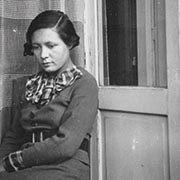The Czech composer Vítězslava Kaprálová, who only lived to the age of 25, left a series of symphonic pieces which are now being published by Bärenreiter Praha. Her works are characterised by a great wealth of invention.
Amongst Czech composers of the 20th century there are still many unknown or little known figures even though we are dealing with some remarkable compositions. One of these is the composer and conductor Vítězslava Kaprálová (1915–1940) who died at a young age, and whose life was surrounded by many romantic events. Kaprálová’s life and work have not been fully researched until now, and her inventive and original output has only gradually been taken up in the repertoire of a few ensembles.
Vítězslava Kaprálová, born in Brno, was the daughter of the pianist and composer Václav Kaprál (1889–1947), a pupil of Leoš Janáček at the Brno Organ School. His gifted daughter began composing at the age of just nine under her father’s tutelage, and shortly afterwards she entered the Brno Conservatoire were she studied composition and conducting. In 1935 she then attended master classes at the Prague Conservatoire. She completed her composition studies with Vítězslav Novák and continued conducting studies with the renowned Václav Talich. Kaprálová’s association with Bohuslav Martinů is often referred to; she got to know him well both artistically and as a friend during her studies in Paris. Martinů gave Kaprálová his new works to study and arrange, and he himself corrected her new pieces. Kaprálová’s life ended against the background of the dramatic events of the Second World War, which she experienced in France. She died of tuberculosis on 16 June 1940 in Montpellier.
Although the composer only lived to the age of 25, she managed to write about 58 pieces during her short life. These include song cycles, pieces for solo instruments, melodramas, chamber music and a few pieces for orchestra, such as the Vojenská symfonieta (Military Sinfonietta) op. 11 (1937) and the incomplete Concertino for violin, clarinet and orchestra op. 21 (1939).
The Military Sinfonietta op. 11 was the composer’s first larger orchestral piece, although she had gained experience of orchestral writing when composing a piano concerto in 1935. Kaprálová began the orchestral piece at the instigation of Vítězslav Novák; she only added the epithet “military” later when she herself became aware of the boldness of her style and a certain march character in the piece. Its melodic style, rich in intervals of fourths and fifths, also points in this direction. The Sinfonietta expresses the restless character of the time and the world in which people began to sense the threat of Hitler’s power. Kaprálová dedicated the work to the then President of the Czech Republic, Edvard Beneš, who was also Commander of the Czechoslovak armed forces. The successful premiere of the work took place in November 1937, with the Czech Philharmonic conducted by composer. A little later the score was published by Melantrich Verlag (1938).
The composition of the Concertino for violin, clarinet and orchestra op. 21 (1939) took place against a background of financial difficulties, associated with the impending threat of the Nazi invasion of France. It is one of Vítězslava Kaprálová’s last works. The composer worked on it during the period when she completed the Partita for pianoforte and string orchestra op. 20, and it can be said that both works are organically linked to each other. This is reflected especially in the distinctive contrapuntal writing and an original concept of form, influenced by the composers of the Parisian group “Les Six” and Bohuslav Martinů. The wealth of thematic invention in this work is admirable, with various themes joined together to produce new and unexpected combinations. Kaprálová did not complete this composition, leaving it only in sketch form. Two well-known editors of the works of Leoš Janáček, Miloš Štědroň and Leoš Faltus, have produced an extremely skilful reconstruction of the full orchestral score. The score was published in 2003, but the orchestral parts have only just been prepared and will be used for the first time in a performance of the piece by the Czech Philharmonic conducted by Jakub Hrůša in November 2014.
Veronika Vejvodová
(translation: Elizabeth Robinson)
(from [t]akte 1/2014)



